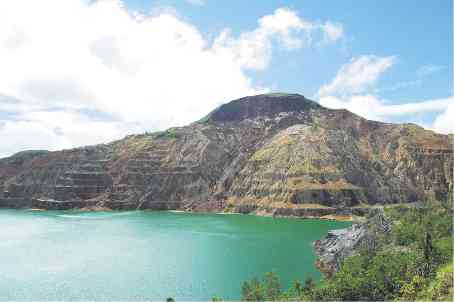
The Mines and Geosciences Bureau is inspecting the abandoned Marcopper Mining Corp. mine site in Marinduque after local officials reported leaks in one of its dams. —INQUIRER FILE PHOTO
The Mines and Geosciences Bureau (MGB) detected leaks in one of the abandoned dams of Marcopper Mining Corp., raising anew public concerns over the integrity of the decades-old mining facility in Marinduque province.
Roland de Jesus, director of the MGB in Mimaropa (Mindoro, Marinduque, Romblon, Palawan) region, said an eight-member team sent to the area found leaks in a diversion tunnel of Marcopper’s Makulapnit dam in Barangay Hinapulan in the capital town of Boac.
De Jesus said the MGB has yet to determine the gravity of the situation. He said “water is gushing” out of the old and rotten tunnel that was installed when the mining company started its operations in 1970s.
The company shut down in 1996 after one of its drainage tunnels gave way, unleashing about 200 million tons of mine tailings into Boac River.
The provincial government in 2005 filed a $100-million class suit against Marcopper and its parent company, Barrick Gold Corp., but the Nevada State District Court threw out the case a decade later.
Not a single centavo had been paid as compensation for what was tagged as the country’s worst mining disaster.
A 1996 report by the United States Geological Survey identified Makulapnit and Marcopper’s other dam, Maguila-guila, as both in a state of “imminent danger of collapsing.”
De Jesus said heavy rain dumped by Typhoon “Nina” (international name: Nock-Ten) in December may have contributed to the tunnel’s deterioration.
He doubted its chance to survive a stronger typhoon, which will bring heavier rainfall or similar to the amount of rain dumped by Tropical Storm “Ondoy” (international name: Ketsana) in Metro Manila in 2009.
Luna Manrique, Boac municipal planning officer, said members of the Citizen Armed Forces Geographical Unit (Cafgu) patrolling the area on Jan. 18 noticed the cracks in the concrete tunnel.
Manrique, in a letter to the Department of Environment and Natural Resources, said water leakage “had significantly increased” from the time he observed it in October 2013.
Makulapnit dam was used to collect clean water from Hinapulan creek that the company used for mining copper. Manrique said the tunnel was large enough that a “dump truck could fit through.”
De Jesus said the technical inspection continues this week to include Maguila-guila, following reports of acid seeping from the mine wastes and flowing into Boac River.
Once completed, the MGB will submit a report and discuss with the provincial government possible measures to address the situation, he said.
Manrique and De Jesus could not say how much volume of water the dams hold.
De Jesus said Makulapnit dam functioned as a siltation pond and as a water reservoir.
He said the leaks were found in the tunnel connected to the water reservoir.
De Jesus said there were no tailings in this reservoir because it holds rainwater and water from the river and creek.
“In fact, the community that used to live inside the Marcopper site tapped water from Makulapnit for domestic use,” he said.
When asked if water in the reservoir is clean, De Jesus said, “We don’t know because [it has not been used for] years.”
The MGB, he said, would conduct sampling to asses water quality.